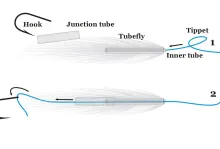So you thought you'd rediscovered the wheel, the deep plate and pre-sliced bread when you discovered articulated flies? Think again! Springulated flies is where things are going.
Articulated flies are so last year! Sure they work and sure all the double hooks, spines and shanks are cool beans, but compared to the rage of this spring (no pun intended), they are stale and stiff and literally dead in the water.
Say hello to springulated flies!
Articulated arthritis
The principle of articulation is adding one or more joints to a fly, making it flexible and able to move in a more natural way in the water. And sure enough, the links do add flexibility to the fly, but as much as they do, they are like wobbly ragdoll’s limp legs compared to real legs: totally out of control.
The renown Danish fly tyer Lars I. P. Olof - known to his friends as Lipo - realized this as soon as he started tying and fishing articulated flies a few years ago, and immediately began thinking of a new hinging system. He went though all kinds of wires, chains, O-rings, hinges and other connections between the front and rear parts of his flies, but found nothing that satisfied him until he started playing with springs.
Tension springs
In cheap tension springs Lipo found a material that perfectly met his demands for a connection: flexible yet controlled and somewhat stiff, even able to allow the fly to work along its axis, an ability not found in the current articulated flies with wire or shank connections, which are numb and have a fixed length.
On fishing with the flies Lipo discovered an added bonus: the springiness of the flies secured him more fish. From gentle nibbles to brutal head on strikes, the spring would ensure a good hookup, and many fish even seemed to give less resistance and put up less of a fight, perhaps because the pull from the line was softened by the spring.
Springulated Tube Flies
The principle is very simple: in stead of using a wire and some pearls as the connection between front and rear, Lipo secures a spring to the front of the rear hook and then ties that onto the front hook once the rear one has been dressed.
Attaching the springs to the hooks proved to be a challenge, though, and soon Lipo ventured into tube flies, and finalized his design on tubes. This meat that he lost the softness of the hookset, but he gained the advantages of the tube flies. He has now successfully fished with what he calls “Springulated Tube Flies” for a few seasons, and felt he was ready to share the revelation with the world.
And he chose the Global FlyFisher as his channel! We're honored.
Spring selection
The main issue with tying these flies is selecting the tube and the spring. The spring must be a tension spring, which springs back together when you pull it apart. These springs are usually sufficiently thin in the material to be soft enough for this purpose. You need the tube and spring to fit together like hand in glove. In other words: the tube must fit snugly into the spring. Most tension springs have an eye in each end, and you will need to bend these to be perpendicular to the spring if they aren't already.
Tying the fly
Tying the springulated fly isn't trivial or straightforward at first, but is partially like tying articulated flies. You will usually tie the rear section first, and then attach the spring to it. Then you tie the front section and attach the spring and the rear section to it when done. This method requires a bit of juggling and reversing the tube on the tube needle, brushing away the materials in order not to catch them when tying on the springs.
It's April, spring is here... and so is springulation!
You use the connection rings on the spring to tie it in and secure it with epoxy or UV resin when done.
Apart from the peculiarity of the spring, the flies can be tied like articulated flies, and many patterns can be converted to springulation.
It's April, spring is here... and so is springulation!
Remember where you read about it first.
- Log in to post comments


















Purchasing springs
Hi all,
a great idea to use such springs - but does anyone knows a vendor for such springs?
LG
joly
Notice the date
Joly,
Notice the date on this post! I'm not sure the spring idea will work for real... but springs can be bought many places. I bought the ones seen here in a store that supplies parts for boats and cars. A whole selection of different springs for almost no money.
Martin